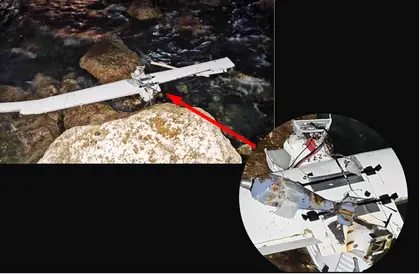A resident of the Bulgarian Black Sea resort of Tyulenovo discovered what appeared to be parts of an aerial drone on which was taped a mortar bomb, or warhead, on Sunday evening. After taking photos of the object the individual reported it to the authorities.
As Kyiv Post reported yesterday, Bulgaria’s Ministry of Defense (BMoD) said on Monday morning that it was sending a specialized Explosive Ordnance Disposal (EOD) team from the Varna Naval Base to deal with the object.
JOIN US ON TELEGRAM
Follow our coverage of the war on the @Kyivpost_official.
On Monday evening BMoD confirmed that the EOD team had inspected the site and concluded that moving or transporting the drone to another location was not feasible. So, officials decided to destroy the objects in situ.
Bulgaria’s defense minister, Todor Tagarev, told reporters “We can certainly assume that it is related to the war that Russia launched against Ukraine. This war is inevitably associated with increasing risks to our security.”
He didn’t provide any additional information related to the drone, including where it came from or how it had reached Bulgaria.
What sort of drone was it?
Evaluation of the photographs taken at Tyulenovo and a comparison with images of other drones leads to the conclusion that this was more than likely a Ukrainian drone, most probably the Dovbush 10T. The similarities between the drone that appeared in Bulgaria and photographs of a Dovbush drone that crashed into trees earlier this year and was posted on social media leave little doubt of the type and origin of the drone.

‘Wild Hornets’ Latest Development Will ‘Sting’ Russian Shahed Drones
Crashed Dovbush 10T drone. Photo: Telegram
The Dovbush T10 drone was the brainchild of the co-founder of Ukraine’s Monobank, Volodymyr Yatsenko. He revealed in April that the drone had been planned during the early weeks of the war but had only now gone into production after they were able to source the necessary components from Europe rather than China.
Yatsenko told Ukraine’s 1+1 TV channel that the company had invested $8 million into the project and produces around ten drones a day which it provides to the Armed Forces of Ukraine (AFU) free of charge.
He claimed that the technical make-up of the Dovbush drone made it resilient against Russian electronic interference but admitted it was susceptible to adverse weather conditions, such as fog, strong winds, and extremely low temperatures but the developers were working to overcome these shortcomings.
Yatsenko said that the current model was designed for reconnaissance and artillery fire adjustment missions with a range of around 40 kilometers. He said it could be converted into an attack drone once the accuracy of delivery was brought down to within a circular probable error of 1-2 meters.
The new drone was announced at the same time as Yatsenko had offered a Hr. 20 million ($550,000) bounty for any drone manufacturer who could land a drone on Red Square in Moscow during Russia’s May 9 Victory Day parade.
Why was a mortar warhead attached to the drone?
The mortar was identified as an 82mm high explosive fragmenting mortar round, based on the original Soviet O-832 design which is widely produced and used in former Soviet and other nations. It contains a warhead [the explosive part of a weapon] of around 420 grams of TNT and has a simple setback arming fuse.
Scrutiny of the Tyulenovo drone shows two black straps which may be an improvised release mechanism allowing the mortar warhead to be dropped on a target. This approach has been common among a range of Ukrainian and Russian drones used in the forward areas of the battlefield.
Alternatively, it could indicate that the drone was intended as an improvised “kamikaze” drone used to fly, under the control of an operator, into a target of opportunity – although the accuracy issue of the Dovbush drone along with its relatively high cost makes this unlikely.
The third alternative is that it was attached to act as an improvised “self-destruct” mechanism to prevent the drone from falling into enemy hands in case of failure during operation.
How did it get to Bulgaria?
This is the sixty-four-thousand-dollar question. How did a drone that had a range of only 40 kilometers end up near the northern Bulgaria seaside resort, which is 70 kilometers from the nearest Romanian border and 300 kilometers or more from any area that would be targeted by Ukraine, including occupied Crimea?
The most likely explanation is that it was blown off course before falling into the sea and eventually being washed up in Bulgaria under the effects of sea currents. The drone was obviously somewhat damaged, but if it had traveled several hundred kilometers through the sea and was still relatively intact, this suggests it is structurally more resilient than its developers believed.
You can also highlight the text and press Ctrl + Enter







